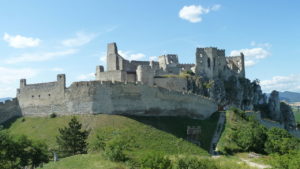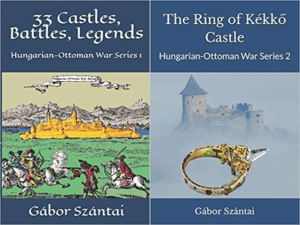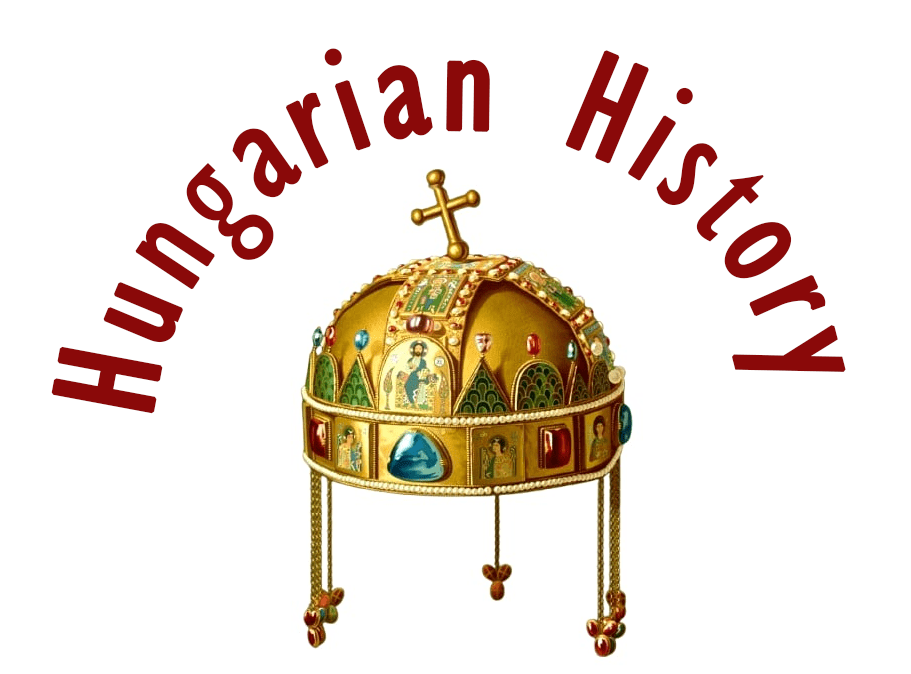Beckó, Bolondóc

Beckó (Beckov, Beckow) castle is a gem of Hungarian medieval history and a precious stone of Slovakia in our days, as it is located in the historical Upper lands/Horná Zem/Felvidék. Both nations can be equally proud of it. The castle is on the left bank of the River Vág. It is also called Bolondóc or Stribor castle, and it was already there in the 12th century. There are several legends of this castle about the cruel Lord Stibor and his death.
Location: https://tinyurl.com/2dw9dkmz

Beckó is said to have been a headquarters of the local Comes of the Hungarian king, it was first mentioned in the Chronicle of Anonymus after 1205. As the fort stands on a 245-meter-high rock, the garrison was able to defend it successfully against the Mongols in 1241. Similar to other fortifications of the northern lands of medieval Hungary, Beckó was also taken by the powerful oligarch called Csák Máté at the beginning of the 14th century. These castles and lands were returned to the king, Károly Róbert, only in 1321.
It was owned by the famous and perhaps infamous Polish knight, Lord Stibo,r in the 14th century, who was a great supporter of King Zsigmond of Hungary. These were the heydays of Beckó when Lord Stibor controlled his lands from there. He turned the place into a splendid palace in those days. The last heir of the Stibor family was Stiborici Katalin after 1434, and she got married to Bánffy Pál of Alsólindva. Thus, the castle became the property of the Bánffy family until the 20th century.

In the Turkish age, it was surrounded by an outer wall, though the battles of the Ottoman wars were far away from this quite safe place. The chronicles recorded merely one occasion when a Crimean Tatar raiding party appeared at the walls of Beckó in 1599, but the garrison could easily scatter them. There were 218 houses in the small town in 1598. Strategically, the castle was not very important, so only one such bastion was built that was able to answer the challenge of the quickly developing artillery.
The settlement below the castle had the right to keep markets as early as 1520. Its Franciscan monastery was built in 1689. During the 17th century, the small town had some guilds: boot-makers, broad-cloth makers, and millers lived there. The Mednyánszky family had a manor and palace there in 1540. Its church is built in the Gothic and Renaissance style. It is assumed that the garrison always opened the castle’s gates willingly to the Transylvanian princes (Bocskai István, Bethlen Gábor, Rákóczi György I.- *Please note that I use the Eastern name order for Hungarian names) when they were attacking the Habsburgs during the 17th century.

The male line of the Bánffy family ceased to exist in 1644, and the female members of the family debated for decades about the ownership of the castle and the 17 villages belonging to it. Sadly, nobody paid attention to the condition of the castle during these years. The last military action took place at Beckó in 1707. The “kuruc” rebels of Captain Ocskay László attacked and took the small town that was surrounded only by a low stone wall. When they assaulted the castle, the defenders repelled them with savage rifle fire. As revenge, the rebels pillaged the town along with the churches.
Moreover, they herded the town’s naked women to the snowy streets, according to contemporary records. When Prince Rákóczi Ferenc II’s army was defeated at Trencsén Castle in 1708, the rebels had to leave the area. We assume that Beckó Castle was not exploded in 1711 by the Habsburgs, like so many forts in Hungary, because its owners were loyal to the king.

There was a huge fire in 1729 when the entire castle burned down. Due to the huge expenses, the owners didn’t rebuild it. Instead, they moved to their more comfortable palaces and stately homes in the surrounding villages. Archaeological work began in 1970, and there were closed areas in 2002 where tourists were not allowed to enter. We can just guess how one of the most impressive Gothic palaces of the Kingdom of Hungary may have looked in the 15th century. Here is my article about the reasons why we cannot find so many traces of Gothic and Renaissance buildings in Hungary:
https://www.hungarianottomanwars.com/essays/why-is-the-hungarian-renaissance-not-so-well-known/

The Legend of Beckó Castle
(by Szombathy Viktor)
“This castle has many legends!
Of all the castles and castle ruins along the Vág River, Beckó is the one with the most tales to tell. How many names alone: Beckó, Blundus, Bolondos, Bolondóc, and how many lords there were: King Béla, King Károly, King Zsigmond, the Bishop of Nyitra, Csák Máté, Voivode Stibor, Bánffy Miklós, Rákóczi Ferenc, the Mednyánszky barons, and many more.
The ruins of the castle are still visible from Vágújhely, opposite Bogoszló. It leans almost against the Inóc Hills, facing the White Carpathians. The forest, which is its backbone, starts at Galgóc and reaches up to the Beskid Mountains. If you manage to enter the castle courtyard – a fence protects the ruins – you can wander for hours among the stones, stairs, fallen towers, empty windows, rickety ledges, and chilly niches. Just don’t go near the edge of the cliff: it’s dangerous.

One of the stories is about this steep cliff.
One of the most famous owners of the castle was Voivode Stibor, a Polish-born lord, a favourite of King Lajos the Great and King Zsigmond. Legend has it that before the castle was built, Voivode Stibor and his men hunted in the Inóc Hills. One of the most amusing was Beckó, the clever and wise court jester. He could make the whole company laugh with his witty sayings and jokes, but that was his job. There was no better entertainer than Beckó the jester during the leisure hours of the wild hunt, around the evening campfire.

It was stag season, the hunt had been going on for three days. On the afternoon of the third day, they took a long rest. Roast venison legs and grouse were roasting on spits, the court cooks of the Voivode were busy with their spits, bowls, and pans, and the court wine maker was busy with his wine jug. The gentlemen were in high spirits, the hunt had been very successful so far.
In the merry din of eating and drinking, the host, Stibor, suddenly spoke:
– What is the King doing in Buda now, sire Zsigmond the King?
The gentlemen guessed, but Stibor did not like any of the answers. He looked at Beckó, who was busy with a rabbit’s leg:
– What would you say, Beckó?
– ‘His Majesty is, as usual, this moment, making a debt,’ said the fool, promptly.
Everybody laughed and agreed.
– “‘This fool of mine is a clever man,’ said the Voivode, Lord Stibor, holding up a cup of wine.
– “Well, if you are so clever,” one of the Podmaniczky turned to him, “tell me, what is it: yellow and red, fiery and lukewarm, up one side and down the other, and when it is dark, is it light?
– The sun!” said the fool.
– You’re right,” laughed Podmaniczky of Manin, but the Bishop of Nyitra was not to be outdone:
– Tell me, if you are so clever, why was Christ crucified?
Well, he shouldn’t have asked that! Because Beckó answered right away:
– Well, because Jews are clever people. They thought that if the Father had eternal life, why would they need a Son!
Now they laughed at the bishop’s expense, that Beckó had hit the nail on the head. Voivode Stibor was possessed by generosity. He lifted his bonnet, waved for silence, and said:
– I love your wit, Beckó. Ask me anything, and I will give it to you.

Beckó smiled sourly, as if he had just bitten his tongue:
– ‘My lord, mighty Voivode, you have promised me much, you have given me nothing, you are not very generous towards me.
The lords and servants smiled now under their moustaches; it was not fitting to laugh at the host, but they agreed with the fool. Voivode Stibor was a little ashamed:
– “Ask, and I will give,” said he.
– ‘Very well,’ said Beckó, taking a deep breath, ‘look, my lord, here is this great rock, build me a castle on the rock.
Stibor was astonished; he had not thought of such a request, but then he nodded, for all eyes were on him, and no one believed that Stibor would keep his promise.
– I will give it to you. In two years, the castle will stand!

Stibor took all his serfs, carpenters, masons, quarrymen, limers, bricklayers, and plankers to build the castle. Those who refused to work were forced to. He chained the raftsmen across the waters of the Vág and made them work as labourers, and those who crossed the ferry were taken away. Carpenters, upholsterers, metalworkers and dog groomers arrived. Horsemen and cooks, gardeners and well diggers.
Two years later, the castle was finished. Everyone stood before it in awe. The new castle pleased the fool Beckó, but even more the lord himself, the Voivode Stibor. He became serious.
– ‘This castle is too big and too beautiful for you,’ he said to Beckó.
– ‘I didn’t say what castle to build,’ said Becco, ‘but if you build it for me, I’ll move in. I like it best of all.
– I’ll take it from you!
– Then you were lying from the start, you didn’t keep your word.
– I’ll buy it from you.
– “That’s still the better case,” shrugged the fool, “because I know you’d take it from me anyway. ‘If you give me as much gold as I can carry on my back, the castle is yours, and I have one condition. That the castle should bear my name!
– ‘Very well,’ breathed Voivode Stibor, ‘take your gold, and the castle will be called Beckó and Jester (Bolondóc in Hungarian).
So it was done. In this way, Voivode Stibor kept his word, gave Beckó a sack of gold, and even dated his letters ” Written in Bolondóc…”

Beckó Castle was bathed in splendour, and Stibor loved it best of his thirty castles. However, the serfs, soldiers and servants of the castle did not like Stibor’s presence at home, for when he was in a bad mood, he was cruel to them. The whip and the cane moved swiftly in the hands of the guards, and it was not only Stibor who was cruel, but also his wife, Dobrochna.
It happened one summer day that a world-famous wedding was taking place in the castle, the son of Voivode Stibor, Imre, was holding his wedding with Szécsen Katalin. During the merry dance, the viceroy’s favourite greyhound came running in, whimpering and squeezing, and ran under the table.

– “Who dared?” jumped up angrily the father of the bride, Voivode Stibor.
An old servant limped in, his hands bloody:
– It was an accident, sir! I was carrying wood to the kitchen, a log fell on the dog. He bit me, I hit him back.
The spirit of the wine was already steaming in Voivode Stibor, but it was a wicked spirit, not a forgiving one, so the Voivode kicked the chair out from under him, and ordered it with anger:
– Throw him down from the rock!
– ‘My lord,’ said the old servant Máté, falling on his knees before the lord of the castle, ‘thou wilt not do this to me.
The guests begged, even the bride pleaded with her father-in-law, but Stibor would not give in.
– What I said, I said, take him!
They dragged old Máté away. He turned back from the door:
– “‘Curse you, voivode! You’ll follow me in a year!”

He could say no more, and the guards pushed him away and threw him into the deep. His screams could not be heard.
A year passed, and the feast still stood. Now the wedding party was in farewell, the guests in turns, the young husband and wife. In the meantime, Voivode Stibor had already been to Buda, and had just returned from there, and was throwing himself into the festivities with renewed gaiety. He rose from the table, tired and intoxicated, and to find rest, he wandered into the cool castle garden and lay down under a shady linden tree. He fell asleep, fell into a deep sleep.
A snake crawled out of the crack in the stone wall, a venomous viper. It coiled to and fro, and as the lord’s hand swung in sleep, and struck the snake a great blow, the snake attacked the sleeper, and plucked out both his eyes. Stibor awoke, he could not see, and in his pain, he ran madly into the blind world, straight to the edge of the cliff, and fell where the old servant had been thrown into the abyss a year before.
Thus, the curse was fulfilled.
The spring water by which the Voivode fell asleep still gushes today, and the overhanging cliff is still called Dobrochna’s Stone after Stibor’s wife. Old people have even seen two black ravens flying here. Stibor is one, Dobrochna is the other, and they are doomed to circle until the last stones of the castle crumble.
But that will be a long time yet.
For the stones have stood the siege of the Turks, the cannon of the Labanc, and have surrendered only to Ocskay László in the name of Rákóczi. Then it was struck by lightning, devoured by showers, and finally burned by fire.
Beckó collapsed. Two hundred and fifty years ago.
But if you look carefully, you can still see the raven.
Source of the legend: Szombathy Viktor: Száll a rege várról várra (Madách Könyvkiadó, Bratislava, 1979)

Dear Readers, I can only make this content available through small donations or by selling my books or T-shirts.
If you like my writings, please feel free to support me with a coffee here:
You can check out my books “33 Castles, Battles, Legends” and “The Ring of Kékkő Castle” on Amazon or Draft2Digital, they are available in hardcover, paperback, or ebook: https://www.amazon.com/dp/198020490X or at https://books2read.com/b/boYd81
 My work can also be followed and supported on Patreon: Become a Patron!http://Become a Patron!
My work can also be followed and supported on Patreon: Become a Patron!http://Become a Patron!




























